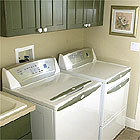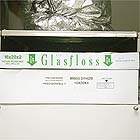Orlando Sentinel : Real Estate
|
PHOTOS
Wall-to-wall cool.
(STEPHEN M. DOWELL/ ORLANDO SENTINEL) Sep 2, 2001
No sweat. FAST FACTS What: Central Florida Where: 12038 Cypress Landing Ave. at
Cypress Landing, When: 10 a.m.-4 p.m. Admission: Free. Directions: Take State Road 50 through Clermont and go south on 12th Street, also County Road 561. Go about 2 miles to Cypress Landing on the left. Details: 352-394-5555 |
G.K. Sharman | Special to the Sentinel
Posted September 2, 2001
Builder Paul Fallman is pleased with the air-handling unit he put in his latest house.
The centerpiece is a cost-efficient heat pump, and next to the indoor portion of the mechanism is a dehumidifier that removes moisture from the air when the air conditioning is off. It keeps the humidity level below 50 percent, making the home pleasant at higher temperatures.
"You could be comfortable in this house at 80 degrees in the summertime," he said.
The air-handling system is part of an energy-efficiency package designed to conserve electricity, help the environment and save money.
The house is a DREAM - which stands for Durable, Resource Efficient, Achievable Model - and it sits on a corner lot in Cypress Landing, an upscale subdivision off County Road 561, south of Clermont. Fallman built the house as part of a government program that aims to cut energy usage in half.
The Florida Solar Energy Center does the testing, and the U.S. Department of Energy provides funding for the program, called the Building America Industrialized Housing Partnership. Fallman, owner of Fallman Design and Construction of Clermont, is the only Central Florida builder active in the program.
Working in conjunction with the air handler is the ductwork, which was installed in an insulated chase in the attic. The chase keeps Central Florida's extreme summer temperatures away from the air-conditioning ducts and prevents leakage of cool air into the attic, Fallman said. As a result, the air-conditioning unit doesn't have to work as hard.
All the parts have to work together for energy efficiency. The heat pump has a SEER, or seasonal energy efficiency ratio, of 12.0, which is the standard measurement of how energy efficient a unit is. A SEER of 12.0 is becoming the minimum rating for air-conditioning systems, up from 10.0. Fallman said he chose the 12.0 because it is energy efficient and cost-effective.
Bells and whistles
After everything was in place, an independent energy-testing firm conducted a blower-door test to determine how air-tight the home is. Fallman's house scored 91 on a 100-point scale. Energy Star homes, which are designed to be 30 percent more energy efficient than the typical home, generally score 86; a typical home measures 80.
The home includes all sorts of energy-efficiency bells and whistles, such as:
R-30 insulation in the attic.
A concrete tile roof, which reflects heat and keeps the attic 30 to 40 degrees cooler than conventional shingles.
6 3/4 7 -inch rigid insulation on all exterior block walls. The insulation is then sealed with tape at all the joints to create a tighter seal.
Insulated, tinted windows that deflect heat and help keep the home cooler. In addition, all windows and doors are sealed with foam sealants.
Insulated fiberglass exterior doors with insulated glass.
A digital programmable thermostat.
A gas fireplace instead of wood-burning.
A passive solar water heater. The unit sits on the roof and has pipes that feed into the electric unit. Working together, they provide a capacity of 90 gallons of hot water. Standard water heaters provide 30 to 50 gallons.
Many of the upgrades are more efficient versions of what's already in most houses - Energy Star appliances, for instance, which use less energy and save money over the long run.
Other upgrades are smarter ways of doing ordinary things - putting the dryer on an outside wall so it can vent directly outdoors instead of through the attic, for instance. The laundry room also has a window and a door for additional ventilation.
Still other upgrades are just plain Florida common sense - using ceiling fans or building a porch.
Fallman also made extensive use of fluorescent lighting, which he called "the sliced bread of energy efficiency."
Fluorescent bulbs generate less heat than regular bulbs, he said. He installed one in his own office and has noticed a difference in temperature. The fluorescent bulbs may cost more but they last longer - as long as 12 years, he said.
A home's design plays a role in energy conservation as well. Fallman used passive solar techniques such as large porches, especially on the rear, and larger than normal roof overhangs.
It would have been nice if the northwest-facing house could have faced a different direction, he said, but he didn't have a choice in how he positioned the house on the lot. One window faces the blazing afternoon sun. Fallman cushioned the effect with the larger roof overhang, insulated windows and a tree right outside the window, which one day will provide shade.
The home includes several health and comfort features as well, such as counter tops that don't absorb moisture and wood or tile flooring in most rooms, which cuts down on the dust, pollen and pet dander than can become trapped in carpet.
Costs and payoffs
The house sports a price tag of $294,000, which Fallman said is comparable with other homes in the neighborhood. He's building on several other lots as well.
But homeowners don't need an executive paycheck to enjoy the benefits of energy efficiency, he said.
Most of the homes he builds are in the $170,000 range, he said, and he incorporates as many energy-saving attributes as possible. His own house in Clermont is Energy Star certified, he said.
"You can do this [energy efficiency] in a $100,000 house," Fallman said.
On the front end, though, energy efficiency isn't always cheap. A solar unit such as the one on the roof of the DREAM home can cost $1,800, the Energy Star refrigerator is $150 more than the one Fallman usually puts in the homes he builds, and the washer and dryer retail for around $1,100.
In the long run though, he said, energy efficiency costs less. Fallman estimated that he put about $3,000 worth of energy upgrades throughout the house.
That works out to about $20 more per month on the average mortgage, he calculated. But the upgrades could save the homeowner $30 a month in utilities and other costs.
The washer and dryer, for instance, costs $100 less per year to operate, he estimated.
Air conditioning - probably the single biggest electrical cost in a Florida home - would average about $75 a month, he said.
So why don't other builders use energy-saving techniques? Because everybody - builders and consumers - concentrates on the "sticker price," the cost per square foot, he said. Things such as porches, overhangs or better appliances don't count.
Energy efficiency "doesn't show up when you figure cost per square foot," he said.
Other builders may have to make changes soon, he said. New building codes that require energy-efficient measures go into effect next June.
Until then, Fallman may have the most energy-efficient home on the block. It saves money, stays comfortable and helps the environment.
If only it were self-cleaning.
Copyright © 2001, Orlando Sentinel


